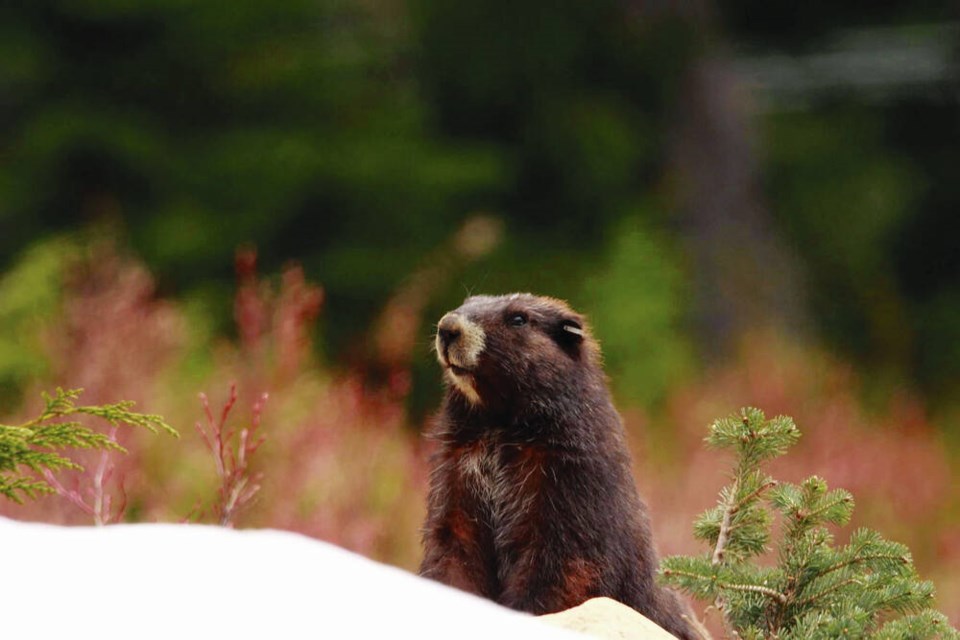The snow pack is long gone in the alpine regions of Vancouver Island and that’s a concern for those trying to save one of the world’s most endangered mammals.
This weekend, 52 captive-bred yearling marmots will be introduced to existing colonies around Mount Washington. Most were born at the Marmot Recovery Centre on Mount Washington, but some have also come from programs at the Calgary and Toronto zoos.
With only 200 Vancouver Island marmots remaining in the wild — all in 27 colonies ranging in size from four to 30 and stretching from the Strathcona Provincial Park to Mount Washington and Nanaimo Lakes regions — drought conditions could make it hard for them to survive, say experts. “If there’s no moisture to sustain plants and food sources, it will be a tough year for them,” said Adam Taylor of the Marmot Recovery Foundation. “It’s sort of like the only watering hole in Africa … where there’s a source for food, the [marmots] will go there and it will attract predators.”
He said drought is more of an immediate threat than wildfires because the marmot habitat is in meadows and less-wooded areas.
Taylor said marmots rely on healthy vegetation for themselves and their pups, and expending the energy to travel longer distances is physically taxing and puts them at risk of being preyed upon.
While they have extensive “escape trains” of burrows and hiding places, when marmots have to range far from their dens for food — particularly their favourite, the sugar-laden lupin plant — they are exposed to predators like golden eagles, cougars and wolves.
Although it’s still early, sightings from the alpine has been positive for the marmots so far this spring, said Taylor. Most of the estimated 200 survived their overwinter hibernation, and there are already indications that pups are on the way.
New pups will start emerging from their dens during the first week in July, when teams will begin a new count and estimate the overall population.
Only two mortalities of the existing wild population have been recorded so far, said Taylor. And two new fledgling colonies have been recorded in Strathcona Park, where breeding marmots have taken up new areas.
The conditions are the opposite of last year, when the snow pack was high and persisted into late June. About 50 marmots were lost in 2022 and there was virtually no reproduction in the wild, said Taylor, because the late “extreme” snow pack hindered the marmots from finding enough food.
Mount Washington Ski resort held a Father’s Day ski day last year because of the abundance of snow in the alpine.
Taylor hopes the release of the captive-bred marmots will help the wild population recover, though challenges with food and predation have hurt the population.
The Island’s unique marmot species hit a low point of fewer than 30 animals in 2003. Breeding programs at the Calgary and Toronto zoos and at the Tony Barrett Mount Washington Recovery Centre — as well as huge habitat-protection projects — have helped to bring populations back from the brink of extinction.
In 2013, the population hit a high of 346, but weather and predators, among other factors, took a huge toll. The following year, 266 animals were counted. By 2017, the numbers had dropped again, to 167. Since then, the population has been slowly recovering.
British Columbia’s only endemic mammal is also Canada’s most endangered mammal species. The Vancouver Island marmot (Marmota vancouverensis) is also considered one of the most endangered mammals in the world.
A recovery effort for the species was initiated in 1997 by a group of partners including the Marmot Recovery Foundation, the province of B.C., the Toronto Zoo, Calgary Zoo, Mount Washington Alpine Resort and timber companies now operating as Mosaic Forest Management.
Recovery involves captive breeding and reintroductions, translocations, habitat restoration, supplemental feeding and extensive monitoring.
Since 2003, a total of 576 captive-bred marmots have been released, and the wild population has climbed to about 200.
While they’re still critically endangered, a 2020 study by the International Union for Conservation of Nature put the marmot in a small group of 48 birds and mammals worldwide whose extinctions have probably been prevented by conservation actions.
>>> To comment on this article, write a letter to the editor: [email protected]



